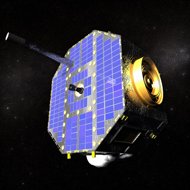LOS ANGELES (AP) — A glimpse beyond our solar system reveals the neighborhood just outside the sun's influence is different and stranger than expected, scientists reported Tuesday.
One oddity is the amount of oxygen. There are more oxygen atoms floating freely in the solar system than in the immediate interstellar space, or the vast region between stars.
Scientists were unsure why, but they said it's possible some of the life-supporting element could be hidden in dust or ice.
"We discovered this big puzzle — that the matter just outside of our solar system doesn't look like the material inside," said David McComas of the Southwest Research Institute in San Antonio, Texas.
The discovery came from NASA's Interstellar Boundary Explorer spacecraft, which launched in 2008 to study the chaotic boundary where the solar wind from the sun clashes with cold gases from interstellar space.
Circling 200,000 miles above Earth, the Ibex spacecraft spots particles streaming into the solar system. A protective bubble surrounding around the sun and planets prevents dangerous cosmic radiation from seeping through, but neutral particles can pass freely, allowing Ibex to map their distribution.






